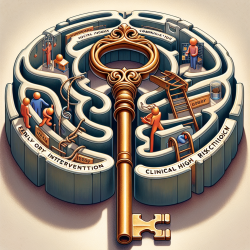Introduction
As a practitioner working with youth at risk for psychosis, understanding the early indicators and intervention strategies is crucial. The research article "Exploring Predictors of Outcome in the Psychosis Prodrome: Implications for Early Identification and Intervention" sheds light on this critical area. This blog will explore key findings from the study and discuss how practitioners can apply these insights to improve outcomes for at-risk individuals.
The Importance of Early Identification
Early identification of individuals at clinical-high-risk (CHR) for psychosis is vital. The study highlights that impairments in social relationships, work/school functioning, and daily living skills often precede the onset of psychosis. These impairments are linked to cognitive deficits, particularly in social cognition, which resemble those seen in individuals with schizophrenia.
Predictors of Psychosocial Outcome
While much research has focused on predicting clinical deterioration, the study emphasizes the need to understand factors influencing psychosocial outcomes. Cognitive and social-cognitive predictors play a significant role in determining the functional outcome of CHR individuals. Practitioners should pay attention to:
- Verbal Memory: Deficits in verbal memory are associated with poorer social functioning.
- Processing Speed and Visual Learning: Improvements in these areas correlate with better social functioning over time.
- Social Cognition: This includes the ability to perceive and interpret social cues, which is crucial for social interactions and overall functioning.
Implementing Targeted Interventions
To improve outcomes, practitioners should consider interventions that target specific cognitive and social-cognitive deficits. Cognitive remediation programs, especially those combined with psychiatric rehabilitation, have shown promise in enhancing both cognitive abilities and psychosocial functioning.
Moreover, social cognition training programs, like the Social Cognition and Interaction Training (SCIT), have demonstrated effectiveness in improving social cognition and reducing aggressive behaviors in schizophrenia patients. These programs could potentially benefit CHR individuals as well.
Future Directions for Research
The study calls for further research to refine early intervention strategies. Key areas for future exploration include:
- Developing age-appropriate measures of psychosocial functioning to better assess outcomes in younger populations.
- Investigating the dynamic changes in cognition and their association with functional outcomes over time.
- Combining neurobiological measures with clinical predictors to enhance the predictive power for schizophrenia risk.
Conclusion
By focusing on the predictors of both clinical and functional deterioration, practitioners can enhance early identification methods and develop targeted, cost-effective treatments. This approach not only aims to improve clinical outcomes but also addresses the psychosocial aspects of at-risk youth, ultimately leading to better long-term functioning.
To read the original research paper, please follow this link: Exploring Predictors of Outcome in the Psychosis Prodrome: Implications for Early Identification and Intervention










